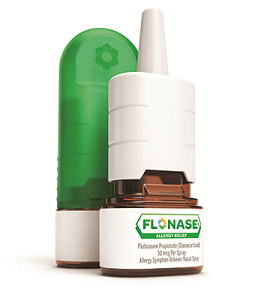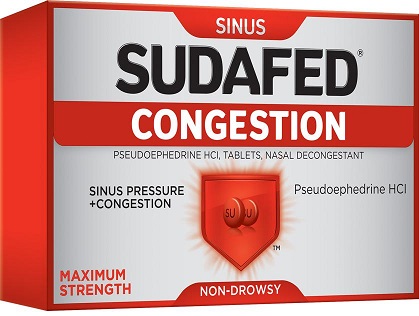Contents
Can you take Flonase and Sudafed together
What is Flonase
Flonase is a Brand name for a nasal spray formulation containing fluticasone as an active ingredient. Fluticasone is a synthetic corticosteroid drug that prevents the release of body substances that can cause inflammation and pruritic symptoms of psoriasis and dermatoses.
Flonase Nasal Spray is used for the treatment and relieving nasal symptoms of seasonal and recurrent nonallergic and allergic rhinitis in adults and pediatric patients of 4 years of age and older.
There are no relevant and established studies and data of Flonase safety and effectiveness in children below 4 years of age. The recommended initial dosage in adults is 2 sprays in each nostril once a day.
Patients who are not adequately responding may use 2 sprays in each nostril two times a day which is the maximum total daily dose. Flonase is available only in the form of spray in dose of 50 ug/1.
Other products on the market containing fluticasone are: Seretide, Nasofan, Flixotide, Flixonase, Pirinase, Flunase and Flovent.
What is Sudafed?
Sudafed is a Brand name for a medication containing pseudoephedrine as an active ingredient that is used as a decongestant for shrinking dilated blood vessels that can cause congestion in the nasal, sinus or ear (Eustachian tube) passages.
Sudafed is used for the temporary relief of stuffy nose and sinus pain/pressure caused by common cold, flu or other breathing illnesses such as allergies, hay fever or bronchitis.
For immediate release dosage forms, usual doses are: 30 to 60 mg orally every 4 to 6 hours, for sustained release dosage forms usual doses are 120 mg orally on every 12 hours and for the sustained release suspension usual doses are 45 to 100 mg orally every 12 hours.
There are many products on the market containing pseudoephedrine such as: Nasofed, Chlor Trimeton Nasal Decongestant, Contac Cold, Drixoral Decongestant Non-Drowsy, Elixsure Decongestant, Entex, Genaphed, Kid Kare Drops, Seudotabs, Silfedrine, Sudodrin, SudoGest, SudoGest 12 Hour, Suphedrin, Triaminic Softchews Allergy Congestion, Unifed.
How does Flonase and Sudafed work in the body
Fluticasone is a very potent vasoconstrictor and anti-inflammatory substance. Its effectiveness is the best in inhaled dosage forms due to its direct local effects. Fluticasone acts by binding to the glucocorticoid receptors.
Unbound corticosteroids molecules can cross the cells membranes of eosinophils and mastocytes, and then bind with high affinity to glucocorticoid receptors.
The results of drug-receptor interaction are: transcription alteration and protein synthesis, a reduced release of enzyme called leukocytic acid hydrolases, leukocyte adhesion to the capillary wall interference, reduction of collagen deposition, reduction of the proliferation of fibroblasts, prevention of macrophage accumulation into the sites of inflammation, reduction of capillary membrane permeability and edema, decrease of complement components, inhibition of proinflammatory substances such as histamine and kinin release, and interference with scar tissue formation.
Pseudoephedrine is sympathomimetic amine with direct action on the adrenergic receptor system. The vasoconstriction is produced after α-adrenergic receptors activation that are located on the muscles lining of the walls of blood vessels.
The constricted blood vessels allow less fluid to leave the blood vessels and enter the nose, throat and sinuses, so results are: decreased inflammation of nasal membranes and decreased mucus production.
In bronchi, due to β2-adrenergic receptors activation, this substance can produce relaxation of smooth muscle, causing bronchial dilation and decreasing congestion and breathing difficulties.
Can patients take Flonase and Sudafed together
It is recommendable to take Flonase and Sudafed together in a short-term period (2-3 days). Very blocked or runny nose can prevent the effects of Flonase spray to get work.
A decongestant such as Sudafed may be useful. A decongestant has an effect to clear a blocked nose and can help to open up the airways by constricting blood vessels while Flonase can help to reduce inflammation. However, patient should take these drugs together only if their doctor prescribed them.
The table below shows side effects after Flonase and Sudafed administration in recommendable doses. The incidence can be significantly increased if these drugs are overdosed or taken together.
| Very common side effects >10% | Headache (17%), Upper Respiratory Infection (15%) |
| Common side effects 1-10% | Pharyngitis (6-8%), Nasal congestion (8%), Asthma symptoms (3-7%), Dysphonia (4%), Cough (3-4%), Dry mouth (3%), Hyperkinesia (3%), Fatigue (3-4%), Fever (1-5%), Aches and pains (1-3%), Flu-like syndrome (1-3%), Bronchitis (1-3%), Abdominal pain (1-3%), Diarrhea (1-3%), Nasal ulcer (1%) |
| Frequency Not Defined | Loss of taste, Insomnia, Nausea, Vomiting, Tremor, Restlessness, Nervousness, Ventricular premature beats, Ischemic colitis, Hypertension, Atrial fibrillation, Myocardial infarction |
| Postmarketing Reports | Rhinalgia, nasal discomfort , nasal dryness, and nasal septal perforation |
Special precautions and warnings during Flonase and Sudafed administration:
- Patients should tell their doctor and pharmacist if they are allergic to fluticasone or pseudoephedrine any other medications, or any of the ingredients in Sudafed products or Flonase nasal spray.
- Patients should tell their doctor and pharmacist what prescription and nonprescription medicines, nutritional supplements, herbal products or vitamins, they are taking or plan to take. Patients should mention to their doctor if they are using some of following drugs: an antifungal drugs such as ketoconazole (Nizoral, Extina, Xolegel) and HIV protease inhibitor drugs such as ritonavir (Kaletra, Norvir). They should also tell their doctor and pharmacist if they are using steroid medicines such as: methylprednisolone, dexamethasone, and prednisone. Doctor may need to change the doses of medicines or monitor you carefully for side effects.
- Patients shouldn’t use these medicines if they have used MAO inhibitors drugs such as furazolidone (Furoxone), phenelzine (Nardil), isocarboxazid (Marplan), selegiline (Eldepryl, Emsam, Zelapar), rasagiline (Azilect), or tranylcypromine (Parnate) in the last 14 days. Drug interactions can occur, leading to serious side effects.
- Patients need to tell their doctor if they have recently had nose surgery or nose injury, if they have nose sores, or if they have or have ever had cataracts eye glaucoma, asthma or any type of infection. Also they need to tell their doctor if they have measles, chicken pox or tuberculosis.
- Women should tell the doctor if they are pregnant, plan to become pregnant, or are breastfeeding. These drugs shouldn’t be used during pregnancy and breastfeeding.
- Patients should ask their doctor or pharmacist before using Sudafed if they have: high blood pressure, some heart disease, diabetes or a thyroid disorder.
- Older patients can be more sensitive to the side effects after Sudafed administration, especially for: fast/irregular heartbeat, problems urinating, dizziness, confusion or trouble sleeping.


